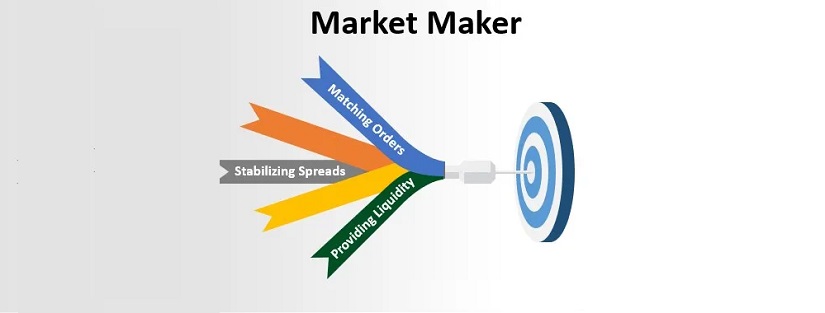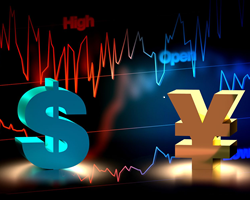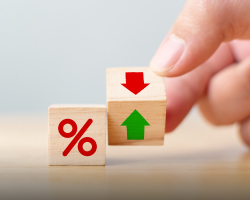What Are Forex Market Makers And How Do They Work?

The financial market is a complicated system where traders strive for profitable trading. To get what they want they should learn how to bypass obstacles on their way. You can do this only if you have reliable information. Today we will tell you who market makers are and what they do.
Forex Market Maker: the Notion and Types
The reason for panic when (as you think!) price does not behave "correctly" and constantly takes your money at unexpected reversals, rapid price hikes, or gaps, is ignorance of how financial markets work. You need to clearly understand what happens after you have clicked the "Sell" or "Buy" button, to whom your order is directed, at what price it will be executed and who and how determines this price.
A market maker is a financial institution that enters into a special agreement with exchange and, for certain benefits or a portion of the profits from the spread/commission, undertakes to:
- for some time (up to 70% of trading) guarantee ("keep") the difference between the purchase price and the sale price (minimum spread) within an agreed-upon range;
- maintain stable liquidity of the market;
- provide other services to clients, such as complex analysis of market trends.
These traditionally include Central banks (influencing the market with financial interventions and interest rates); commercial banks (constantly converting huge volumes of currencies), hedge funds, multinational corporations, and big brokers, private and corporate players - anyone with sufficient capital and technical ability to seriously influence the market.
This is exactly what an ordinary trader interacts with when he tries to trade: market maker forms (quotes) market price (make price) and the market user asks for the price (take price) and, if he is satisfied with the price, closes a deal. As a participant of exchange trading, the market maker is always present on both sides of the market, both as a buyer and as a seller. They are divided into two types according to the level of their influence on the market:
Institutional. Organizations that maintain the balance between supply and demand, prices, and trading volumes within the framework of an agreement with the exchange.
Speculative. Participants can independently influence price fluctuations with large volumes of traded assets.
Main Functions of Market Makers
Market makers, no matter what sharks they are in the eyes of newbies, the main purpose of their activity is to keep the liquidity of exchange instruments and to support trades for traders with modest deposits. Exactly they allow making transactions at an adequate price in reasonable time intervals. Thus, it is possible to allocate the following main duties of a market maker:
- keeping quotes within a certain range;
- provision of additional liquidity as needed;
- prevention of price gaps.
In order to achieve their goals, market makers fulfill contractual obligations: they buy and sell shares, futures, or currencies, predict price fluctuations and regulate lot volumes to maintain liquidity. According to the type of functionality performed market makers can be divided into two types:
Order takers. They trade on the client's order as an intermediary.
Order makers. They make forecasts for specific stocks by observing the market.
How a Market Maker Works
Everyday market makers make a huge number of transactions, maintaining high liquidity of exchange assets. Continuous work includes many operations:
- buying and selling assets at the request of the client;
- brokerage to earn on the spread;
- currency trading;
- confrontation with the market - sale of shares when prices are rising and vice versa, in order to maintain the balance of supply and demand.
At the same time, the analysis of the situation at the exchange is not in the usual for traders horizontal variant, but in the vertical. The market makers have access to the order book, where they can see not only buy and sell operations, but also the pending orders, Stop-Losses, and Take-Profits. They evaluate market trends, potential earnings, and the reliability of the stock, notifying smaller dealers of withdrawals. The bids are put together, and a trade is made that is as profitable as possible for all parties. If there is no suitable buyer or seller on the exchange, the company that has a contract with the exchange is obliged to act as one.
The earnings of market makers are made up of several components:
- payments from the exchange;
- a portion of the spread from the execution of orders of investors;
- speculation;
- investments.
The main part of the income is the exchange payments under the contract because the purpose of market makers is to maintain a stable liquid market. Forex also allows you to make money on the spread, where the probability of a reverse trade is high.
Major Market Makers
One of the most notable players is NASDAQ (National Association of Securities Dealers Automated Quotation System). Among its members are 500 companies that regulate liquidity on stock markets.
In the forex market the largest global banks act as market makers:
- Deutsche Bank - 19.3%
- UBS - 14,85%
- Citi - 9%
- Royal Bank of Scotland - 8.9%
- Barclays Capital - 8.8%
- Bank of America - 5.29%
- HSBC - 4.36%
- Goldman Sachs - 4.14%
- JP Morgan - 3.33%
- Morgan Stanley - 2.86%
They interact with lower-tier participants (liquidity providers), and they, in turn, provide a variety of quotes to brokerage companies.
Due to the high liquidity provided by these banks, the spread of currency pairs is reduced to the fifth decimal place.
Market Makers and Spread
The market has no right to be unprofitable: the buy price must be higher than the sell price. But what does the market maker do if, for example, after the fundamental news, economic or political events in the market there is a large volume of bids to buy, but there are almost no sellers?
That's right, the market maker adjusts ("widens") the spread, to "catch" the offered ask prices. As a result, the bid will be executed at the expense of the market maker, but the price will be much worse than the one the client expects. This is not fraud, but a defensive reaction, though paid with our money. In difficult situations market maker also can not always cope with the situation and suffers large losses - remember the crash test of the Swiss franc on 15.01.2015.
The spread changes depending on the market situation. A decrease (narrowing) of the spread occurs in the search for an optimal price when there is an oversupply of bids (high liquidity), and an increase (widening) - when there is a lack of counter volumes. The exchange spread is always dynamic ("floating") and reflects the balance of supply/demand, the fixed spread could be only for highly liquid instruments. The more market maker participates in the turnover of a certain asset, the better its price will be. For example, the exotic currency pairs have high spreads just because of weak demand.
How Does the Market Maker See the Market?
Our conflict with market makers is not in the complexity of analysis but its direction. The average trader performs only horizontal price analysis, trying to predict future dynamics using mathematical methods (indicators, levels, patterns). Horizontal analysis works only with the past (price history). The trader does not see what is happening in the market and why the price "does not follow the indicator", so all the forecasts are inefficient.
And the market maker does not care what the RSI shows, where the MACD is moving, and whether the "Head & Shoulders" is completed. The price past practically does not influence the current price, but only gives data for estimating the probability of its direction. The market maker perceives and analyzes the market vertically: it sees the price, volume, direction, order type, and Stop-Loss/Take-Profit, accumulation, and dynamics of volumes in the area of certain price levels. The market maker can see all the market and pending orders (the so-called "Open Interest") with all the parameters: how and when to close the position in the case of a positive or unfavorable outcome. Separately such information can be provided by market makers to some VIP clients as well - it all depends on the amount of capital. In addition to the direct market influence on the price market makers actively uses any kind of insider - financial, political, technical.
How Does the Market Maker Use the Information?
It is not so easy to reverse the market price, but let's not forget: the market maker fully "sees" the trading interest on both sides of the market. There is an opportunity to enter the market at the "right" price, to form false trends and unexpected corrections.
As a rule, at the request of a big player, the market maker can push the price to a strong level, where, for example, the pending orders or large Stop-Loss volume are accumulated, and cause "working off" of those orders. The result is an additional acceleration in the necessary direction. That is, on the one hand, the game is played against the crowd, and on the other hand, the marker maker still needs a part of a small "retail" volume to push the price to its benefit.
It should be understood that the big market maker, such as Deutsche Bank, has no sense to work against small bids - it is always in profit due to the huge volume of operations. But when the liquidity is trying to compensate for a smaller market maker, it may simply not have enough money to overlap the bids, and here it begins: requotes, lost connection, incorrect quotes, "lost" bids, and other troubles.
Like any financial player, the market maker has the right to hedge the risks by regular operations on the futures market, for example, futures or options. The algorithms and details of such trading are complex and not always legal, hence the ideas and rumors of price manipulation. Although market maker seems to be some irresistible force, all its operations on the market are strictly regulated and strictly controlled by international and national regulators, such as NFA, FSA, SEC, CFTC.
Theoretical Absence of Market Makers in the Market
As you have already understood from our article, the task of a market maker is to provide private traders with the opportunity to buy or sell an asset at almost any moment of market movement, no matter how strong or "unfavorable" it may be. These are intermediaries who forcibly and constantly make transactions in the market, maintaining its liquidity.
For example, if there were no such intermediaries, it would be very difficult for you to find a counter bid on your order when the price rises or falls. When there is a strong uptrend, most traders start to get into a long position. However, in order for such trades to be executed, there must be players in the market who at each price level were willing to sell that asset. So who is going to do that if the price is flying up, generating income?
New players simply would not be able to join at those quotes, which they consider being adequate for themselves. They would have to wait for the mark at which the buyers would already be fixing profits. The trend is missed, the chart reverses, and the trader is frustrated with the principles of the market.
Accordingly, without the market makers with their "forced" trading, your order would not be executed at the price you wanted for a long time, continuing to hang in the Depth of the Market. You would not be able to join the trade, and you would not be able to finish the trade at the Stop-Loss level, and you would keep losing your deposit waiting for a counter trade.
As you can see, market makers are not only those who "possess insider information" and "move the markets", but those who basically make online trading comfortable and possible for you.
Market Makers' Traps
Of course, market makers in forex are not white and fluffy creatures. To make more money and achieve their goals, they can set the so-called traps at certain levels, which the price reaches. Of course, it is very, very difficult to see them in real-time, but at least knowing that such a phenomenon exists and trying to recognize it is also an important part of understanding the topic.
False Double Top
You must be familiar with this pattern in graphical analysis: a double top is produced by a combination of Japanese candlesticks, in which the chart reaches one level first, tries to break through it, and then pulls back. Then it tries to break through to the top again, but it does not reach the first level. It turns out that the left top is higher than the right one. This is a sure sign of a trend reversal.
In the case where forex market makers have set their traps at certain price levels, you will see that in a Double Top the left top is suddenly higher than the right. Then the price starts to pull back, you get into a sell position and the chart abruptly reverses and heads up.
Some traders exclaim at this point: "Chart analysis doesn't work!" while others add: "Market makers work."
The reason is that they have placed pending orders for the calculated sums exactly at those levels that the price has reached in the case of the second top and the pivot point from which the chart has moved up.
False Trend Reversal
In low time frames, we can see the following picture. The chart is in a downtrend, everything goes according to the classical scheme of technical analysis: the sequence of three minimums and maximums with each time lower. Traders build a channel and watch for a breakdown of one of its sides.
And then it happens, the chart goes up. Most of the participants have Stop-Losses set at this level since the trend was downward and hence the trades were opened for sale. Some other participants have pending Buy orders at the same level: it is logical, as the trend must have changed to the uptrend when it reaches this level.
But in fact, it does not happen. The market makers have collected all the Stop Losses and open pending orders and simply put the trend back to the same channel it was in before. As a result, traders suffer losses without even being aware of such a trap.
It is most noticeable in time frames up to 30 minutes. If the steady trend sharply changes direction, be careful with your decisions! It is better to wait a bit before placing a long position.
An Unexpected Swing on the News
Another trap in the forex market can be when the price breaks an obvious level immediately after an important news release. Traders instantly pick up on the trend, expecting the move to continue. But they don't: at that very obvious level, market makers also collect pending orders and Stop-Losses, turning the price in the opposite direction.
So, Why There Is a Need for Market Makers?
The main task of market makers is to maintain stable liquidity of the market: they act as intermediaries between the buyer and the seller, and, in fact, they are engaged in the execution of orders of their clients. Outwardly, everything is simple: the volume and price of the bids are visible in the market cup, the optimal offers are brought together and a deal is made.
It is through the market makers that the maximum volume of operations of any market passes, their basic income is spread, and a part of the commission from the exchange. Those quotes that we see in the trading terminal are requested by the broker and depending on the policy and composition of the information of the specific market maker. Of course, the broker also contributes its commercial interest to the price stream, so all companies have different quotes, depending on the degree of honesty and the rate of profit.
Summary
The market maker, as the main element of the market, will always be a few steps ahead of the main mass of players. It is the one who creates the "market future" for us, the scenario we see in the trading terminal. So what should those who don't want to lose their money do?
Just a few tips:
Do not get hung up on technical indicators only and use fundamental analysis all the time - you have to understand every market movement and the factors which make the market crowd act in this way.
Apply cross-market analysis: the currency market is closely related to the stock market and commodities - market makers always use these dependencies for manipulation. There is a lot of information on this subject and it is possible to find assets, which are ahead of the dynamics of the selected currencies and can be useful as additional indicators.
Analyze the data on the real volumes with, for example, Thinkorswin, MarketDelta, Ninja Trader, or special indicators for MetaTrader.
Move to a higher time frame: the big players (except HFT) are not interested in scalping, while the risk of getting under the market maker press is much less for the medium-term trades.
The financial market exists because of the competition between strong and weak, but for the reasonable trader, the big players are not enemies, but simply more experienced partners. With time, the experience and understanding of the mechanism of effective "cooperation" with the market maker comes, which will allow long enough and stably receive profit even with a small deposit.









